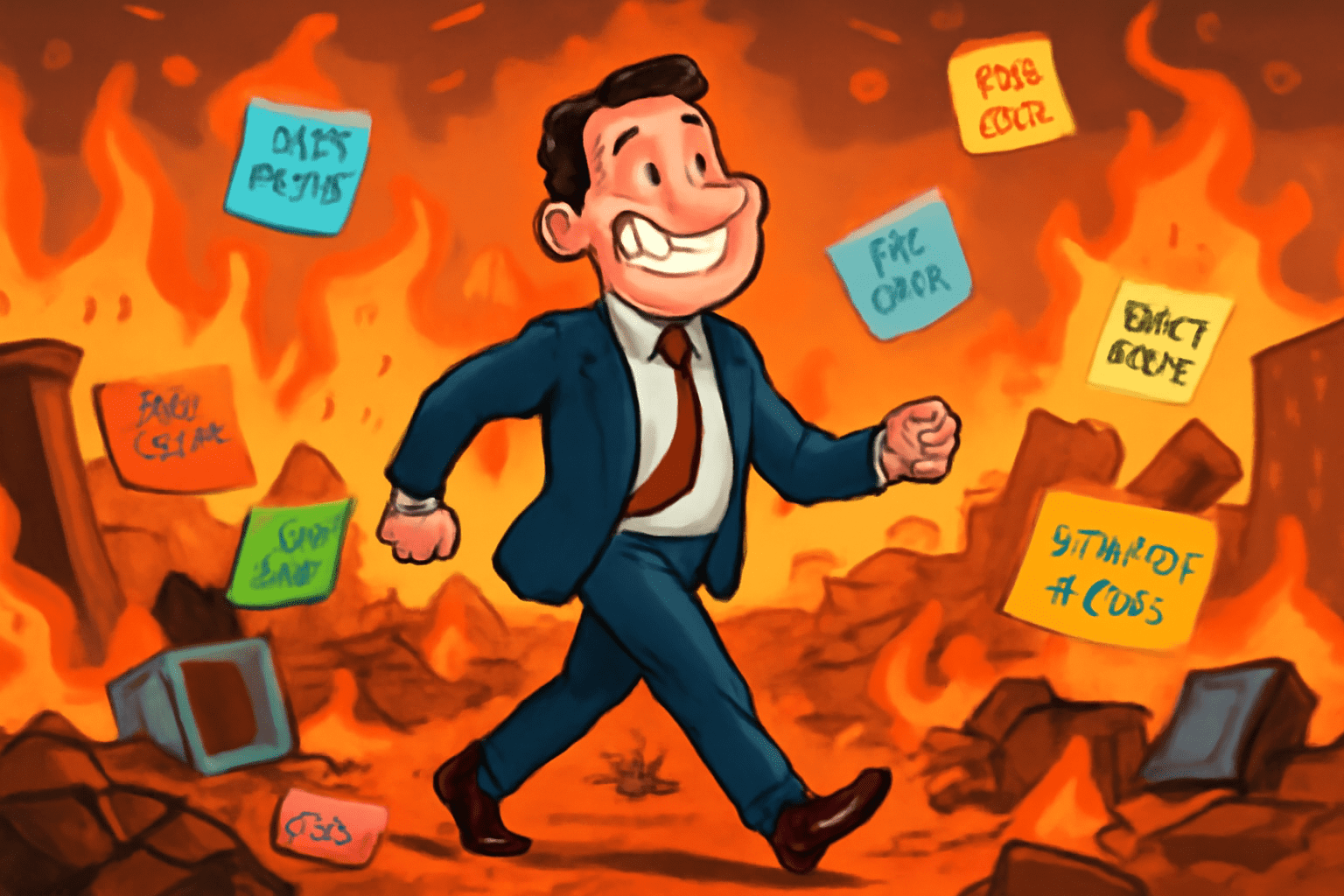A Totally Serious Self-Help Manual on Self-deception (That Will Probably Not Help You at All)
Introduction: Congratulations, You’re Already Thriving (Sort Of)
Welcome, dear reader. If you picked up this manual, it’s either because:
- You suspect you’re a hot mess.
- You already know you’re a hot mess but want to feel better about it.
- You were procrastinating and ended up here instead of doing literally anything useful.
Whichever reason brought you here—congratulations. By the very act of reading this book, you’re officially working on yourself. So pat yourself on the back, pour yourself some iced coffee (because hydration is overrated), and let’s begin your journey into the mystical world of self-deception.
This isn’t a guide to fixing your life. It’s a guide to reframing the disaster zone of your life into a Zen rock garden of confusion. It’s not about improvement, it’s about optics. And really, when people say “fake it ’til you make it,” they don’t mean make it. They mean “make it look like you have it together until everyone’s too exhausted to call you out.”
Chapter 1: Embracing the Power of Affirmations You Don’t Believe
Self-help icons love affirmations: repeat a phrase enough times and it will magically manifest. But let’s be brutally honest—you could repeat “I’m a millionaire” daily while eating ramen and selling plasma, and your landlord still wants rent.
That’s where self-deception swoops in to save the day. Affirmations aren’t about truth—they’re about distraction.
Classic Affirmations, Hot-Mess Edition:
- “My credit score is thriving.” (Even though two debt collectors think you’ve entered witness protection.)
- “I am radiating energy.” (Mostly static shock from your $10 polyester blanket.)
- “I am powerful.” (If by powerful you mean powerfully good at binge-watching reality TV.)
- “I am abundant.” (Yes—abundant in unopened emails and unmatched socks.)
Self-Deception Exercise 1: Shower Choir
As you shower, chant affirmations at the tiles as though they are your unpaid therapist. If your voice cracks, just call it “emotional authenticity.”
Pro Tip: The secret isn’t believing the affirmation—it’s saying it confidently enough that the universe gets gaslit into thinking you’re serious.
Chapter 2: The “Fake It ’Til You Make It” Manifesto
The Manifesto is the holy scripture of self-deception. If you feel like an impostor, the solution isn’t to improve—it’s to lean so hard into performance that the boundaries between pretending and doing collapse into a glittery illusion.
Applied in Real Life:
- Wear business attire while Googling “how to convert PDF to Word.”
- Post a LinkedIn update about “leadership insights” after successfully convincing your microwave to stop blinking “12:00.”
- Offer strong handshakes even if your palms are clammy with fear and unpaid bills.
Self-Deception Exercise 2: The Confident Peasant Walk
Spend a day strutting around as if you’re the protagonist of a Netflix thriller. Don’t overthink. If you drop your smoothie in public, stomp away as though it was part of the plan. That’s not a mess. That’s “performance art.”
Warning: Extended faking may lead to actual competence, which is an accidental side effect. Proceed with caution.
Chapter 3: Gentle Gaslighting (Yourself)
The world gaslights us daily—advertising claims toothpaste brings romance, influencers say their skin routine is better than healthcare, motivational coaches insist you’re “one seminar away” from success. Why not turn that on yourself?
Practical Applications:
- Overslept? That wasn’t laziness—it was “biological optimization.”
- Ate a family-sized pizza alone? That wasn’t shameful—it was “fueling your creative energy.”
- Quit going to the gym entirely? You’re not unmotivated—you’re “radically rejecting fitness capitalism.”
Self-Deception Exercise 3: Rewrite Your Failures
List three mistakes from your week. Now reframe each into a bold choice. Example:
- Broke a glass → “Exploring impermanence.”
- Sent the wrong email → “Committed to surprise collaboration.”
- Forgot a friend’s birthday → “Practicing minimalism in social obligation.”
Before long, failure becomes innovation.
Chapter 4: Redefining Success Until You Qualify
The reason you feel like a disaster isn’t because you’re failing. It’s because you’re working with an outdated definition of success—one designed for people with yachts, assistants, and emotional stability. Your mission is to redefine success in terms you’ve already accidentally achieved.
Traditional Success Metrics:
- High income
- World travel
- Fluency in Mandarin
- Owning a juicer you actually use
Revised Success Metrics of Self-Deception:
- Ate three meals (Oreos count)
- Remembered your Netflix password
- Walked outside (or at least opened a window)
- Didn’t throw your laptop across the room during Zoom lag
Congratulations—you’re thriving.
Self-Deception Exercise 4: The Trophy Shelf of Obscure Wins
Write down the funniest, tiniest accomplishments from your month (“Successfully parallel-parked after seven tries,” “Didn’t cry at work until after lunch”), and display them proudly. Consider making a PowerPoint of your own mediocrity.
Chapter 5: Crisis Branding—Monetize Your Meltdown
Why waste emotional collapse when you can market it? In the influencer economy, vulnerability is currency.
Crash & Cash Techniques:
- Post selfies of your tears with the hashtag #SelfCare.
- Turn procrastination into a podcast concept (“The Art of Doing It Tomorrow”).
- Rebrand crushing depression as “radical introspection.”
Self-Deception Exercise 5: Breakdown Calendar
Schedule your next meltdown so you can go live on Instagram during peak engagement hours. Self-help meets social media strategy.
Remember, even your hot mess moments are content opportunities. If you spin disaster just right, your followers will call it relatable.
Chapter 6: The Rituals of Fake Productivity
Real productivity is boring. Fake productivity, however, is extremely aesthetic—and therefore more valuable.
Approved Routines for Maximum Delusion:
- Elaborate to-do lists where the first task is “make a list.”
- Obsessive color-coded planners that take longer to design than the tasks themselves.
- Buying five productivity journals but never filling past page three.
Self-Deception Exercise 6: Aesthetic Desk Spa
Spend two hours arranging your desk plants, diffusers, and gel pens into perfect Instagram symmetry. By the time you’re finished, you’ll be too exhausted to work. That’s not failure—it’s lifestyle curation.
Chapter 7: Hustle vs. Rest—Choose Both
Self-help culture is divided. Hustlers insist salvation comes through 5 a.m. wake-up calls and grinding. Wellness advocates say healing emerges through naps and essential oils.
But why choose? If you’re practicing self-deception, you can be both:
- Work yourself to exhaustion, then reframe the burnout as “committed excellence.”
- Cancel every responsibility for a week and declare it “radical rest.”
- Shift between extremes so nobody can ever hold you accountable.
Self-Deception Exercise 7: Duality Flow
Set an alarm for 5 a.m. Wake up, write a post about #RiseAndGrind, then immediately crawl back into bed. By 9 a.m., write another post about the importance of self-care. Congratulations—you’re now both a hustler and healer.
Chapter 8: Role Models in Self-Deception
Case Study 1: The Wellness Influencer
- Lives on beige smoothies, cries behind ring lights.
- Claims stress breakdowns are “shadow work.”
- Inspires thousands who don’t realize it’s just good lighting.
Case Study 2: The Corporate Thought Leader
- Speaks in PowerPoint slides full of vague mountain stock photos.
- Uses terms like “scalable ideation” and “synergistic autonomy” while panic-Googling “VLOOKUP in Excel.”
- Entire career built on Power Posing™ and industrial-strength self-deception.
Case Study 3: The Everyday Survivor
- You. Me. All of us. We persist not through brilliance, but through reframing chaos until it feels intentional.
Chapter 9: Advanced Self-Deception—Leveling Up
Once you’ve mastered affirmations, fake productivity, and meltdown monetization, it’s time for advanced tactics.
- Temporal Distortion Technique: Tell yourself you’re “just in a transition phase.” Keep this up for a decade, postponing existential panic.
- Quantum Career Leap: Insist your side hustle is “about to explode.” Hold onto this narrative far longer than investors, family, or logic suggest.
- The Enlightened Contradiction: Simultaneously claim you’re thriving and “still learning.” Both statements cancel each other out, freeing you from accountability.
Chapter 10: The Dark Side of Eternal Delusion
Let’s be real—even self-deception has limits. Pretending you’re fine forever can spiral into full denial. Warning signs include:
- Referring to all failures as “content.”
- Introducing yourself on dates as “a visionary entrepreneur” while working retail.
- Calling debt “abundance in reverse.”
Remember, the goal here isn’t to live in total delusion. It’s to flirt with denial just long enough to survive Monday mornings.
A little self-deception keeps you moving. A lot of self-deception lands you in someone’s memoir section under “cautionary tale.”
Conclusion: Not a Hot Mess, But “In Process”
So there you have it: the complete manual to convincing yourself (and maybe others) that you’re not a hot mess—you’re just a vision of chaotically curated greatness.
Through affirmations you don’t mean, productivity hacks that never work, and crisis rebrands that make calamity look aesthetic, you can thrive in the glorious gray area between failure and Instagrammable success.
Self-help culture promises transformation; this manual promises something far more realistic: entertaining dishonesty. After all, if you can convince yourself you’re not a hot mess for long enough, maybe—just maybe—that becomes the truth.
Faux Recommended Reading
- Goleman, D. (1995). Emotional Intelligence. Bantam Books.
- Trivers, R. (2011). The Folly of Fools: The Logic of Deceit and Self-Deception in Human Life. Basic Books.
- Ehrenreich, B. (2009). Bright-Sided: How Positive Thinking Is Undermining America. Metropolitan Books.
- Brown, B. (2012). Daring Greatly. Gotham Books.
- Robbins, T. (1992). Unlimited Power. Random House. (Optional: Read ironically.)

The Art of Self-Deception: Official Workbook Add-On
(For Hot Messes Seeking Legally Dubious Inner Peace)
Worksheet 1: Affirmation Audit
Instructions: Circle the affirmations you want to “believe” this week, even if reality disagrees. Then write your own delusional affirmations in the blanks provided.
Sample Affirmations:
- I am thriving financially. (Ignore overdraft notices.)
- I am loved and admired. (Yes, even by the barista who spelled your name wrong again.)
- I am healthier than I feel. (That’s just “vintage fatigue.”)
- I am destined for success. (Timelines TBD.)
Create Your Own:
Homework: Repeat these affirmations five times daily, ideally while staring into the blank void of your phone’s black screen.
Worksheet 2: Failure-to-Success Translator
Take your blunders from this week and reframe them as bold intentional choices. Fill in the blanks.
- “I forgot to __________ because I am actually prioritizing __________.”
- “I failed at __________ but that just means I am passionately experimenting with __________.”
- “Spending six hours scrolling TikTok wasn’t procrastination, it was actually __________.”
Bonus Prompt: Share one of your answers on Instagram Stories with a motivational hashtag.
Worksheet 3: Crisis Branding Blueprint
Turn your next meltdown into a marketable moment. Fill in the table.
| Breakdown Event | Rebrand Title | Hashtag | Monetization Idea |
|---|---|---|---|
| Crying in car | “Radical Transparency Session” | #VulnerableAF | Sell tissues with your initials |
| Missed deadline | “Creative Deadline Extension™” | #Boundaries | Launch productivity coaching |
Now create your own meltdown-to-monetization strategy below:
Event: _________________________
Rebrand Name: __________________
Hashtag: _______________________
Possible Merch Line: ____________
Worksheet 4: Success Metrics Recalibration
Traditional success metrics make you feel like trash. Time to set achievable ones.
Old Metric vs. New Reframe
- Old: Earn six figures.
New: Found $10 in coat pocket. - Old: Run a marathon.
New: Ran to catch bus without passing out. - Old: Organize digital files.
New: Renamed “Untitled Doc 7” to “Official Doc.”
Fill in your own below:
- Old: ____________________ → New: ____________________
- Old: ____________________ → New: ____________________
- Old: ____________________ → New: ____________________
Worksheet 5: Fake Productivity Tracker
Each day, fill out tasks you didn’t do but reframed as productive gestures. Example:
- Action: Stared at ceiling for 40 minutes.
- Reframe: Practiced radical mindfulness.
- Action: Reorganized sock drawer.
- Reframe: Decluttered mental space.
Your Version:
- Action: __________ → Reframe: __________
- Action: __________ → Reframe: __________
- Action: __________ → Reframe: __________
Daily Journal Prompts for the Self-Deceptive Soul
Use these prompts to keep your denial system healthy and active.
- What’s one disaster I can reframe as a quirky personality trait today?
- How can I spin my most unproductive moment into a “self-care ritual”?
- Who in my life could be tricked into thinking I’m thriving, and how?
- Which unpaid bill, ignored responsibility, or ruined plan can I market as “minimalist living”?
- If I declared my current chaos “performance art,” how much should I charge tickets for?
Gold Star Page
Every time you successfully lie to yourself with enough confidence to believe it for five seconds, draw a gold star here.
⭐
⭐
⭐
Remember: you don’t need consistent progress—you just need enough stickers to prove you’re “on a journey.”
Closing Exercise: The Mirror Pep Talk
Stand in front of a mirror, stare into your own tired, over-caffeinated eyes, and say:
“I am not a hot mess. I am a limited edition experimental prototype of resilience.”
Repeat until you laugh, cry, or both. Either way—success!





0 Comments